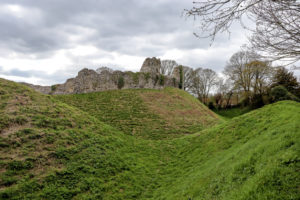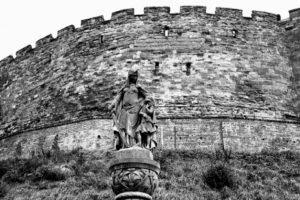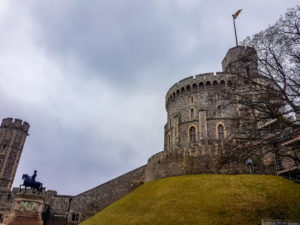Stirling Castle, located in Stirling, is one of the largest and most important castles in Scotland, both historically and architecturally. The castle sits atop Castle Hill, an intrusive crag, which forms part of the Stirling Sill geological formation. It is surrounded on three sides by steep cliffs, giving it a strong defensive position. Its strategic location, guarding what was, until the 1890s, the farthest downstream crossing of the River Forth, has made it an important fortification in the region from the earliest times.
Most of the principal buildings of the castle date from the fifteenth and sixteenth centuries. A few structures remain from the fourteenth century, while the outer defenses fronting the town date from the early eighteenth century.
Before the union with England, Stirling Castle was also one of the most used of the many Scottish royal residences, very much a palace as well as a fortress. Several Scottish Kings and Queens have been crowned at Stirling, including Mary, Queen of Scots, in 1542, and others were born or died there.
Castle Hill, on which Stirling Castle is built, forms part of the Stirling Sill, a formation of quartz-dolerite around 350 million years old, which was subsequently modified by glaciation to form a “crag and tail”. It is likely that this natural feature was occupied at an early date, as a hill fort is located on Gowan Hill, immediately to the east.
The Romans bypassed Stirling, building a fort at Doune instead, but the rock may have been occupied by the Maeatae at this time. It may later have been a stronghold of the Manaw Gododdin, and has also been identified with a settlement recorded in the 7th and 8th centuries as Iudeu, where King Penda of Mercia besieged King Oswy of Bernicia in 655. The area came under Pictish control after the defeat of the Northumbrians at the Battle of Dun Nechtain thirty years later. However, there is no archaeological evidence for the occupation of Castle Hill before the late medieval period.
Other legends have been associated with Stirling, or “Snowdoun” as it was more poetically known. The 16th-century historian Hector Boece claims in his Historia Gentis Scotorum that the Romans, under Agricola, fortified Stirling and that Kenneth MacAlpin, traditionally the first King of Scotland, besieged a castle at Stirling during his takeover of the Pictish kingdom in the 9th century. Boece is, however, considered an unreliable historian.
Another chronicler, William Worcester, associated Stirling with the court of the legendary King Arthur. Tradition suggests that St Monenna founded a chapel here, as she is said to have done at Edinburgh Castle, although it is now thought that the legend of Monenna results from a later confusion of early Christian figures, including Modwenna and Moninne.
The first record of Stirling Castle dates from around 1110 when King Alexander I dedicated a chapel there. It appears to have been an established royal center by this time, as Alexander died here in 1124. During the reign of his successor David I, Stirling became a royal burgh, and the castle an important administrative center. King William I formed a deer park to the south-west of the castle, but after his capture by the English in 1174, he was forced to surrender several castles, including Stirling and Edinburgh Castle, under the Treaty of Falaise. There is no evidence that the English actually occupied the castle, and it was formally handed back by Richard I of England in 1189. Stirling continued to be a favored royal residence, with William himself dying there in 1214, and Alexander III laying out the New Park, for deer hunting, in the 1260s







